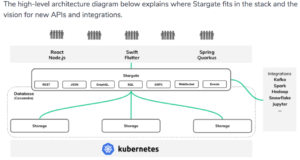
What Is a Service Mesh?
A service mesh is a configurable infrastructure layer for microservices-based applications that makes communication between service instances flexible, reliable, and fast. It provides features such as traffic management, service discovery, load balancing, and security. It typically uses a sidecar proxy for each service instance to handle communication between service instances and to provide these features. Examples of service meshes include Istio, Linkerd, and Envoy.

How a Service Mesh Works
A service mesh is typically implemented as a distributed set of proxies that are deployed alongside application code, and it is responsible for traffic management, service discovery, load balancing, and security.
The data plane of a service mesh is the set of proxies deployed alongside the application code. These proxies are responsible for handling the actual traffic between service instances, and they use the configuration provided by the control plane to make routing decisions.
The control plane of a service mesh is the management component responsible for configuring and maintaining the proxies in the data plane. The control plane communicates with the proxies in the data plane to propagate configuration changes and gather telemetry data. Here are the control plane’s main areas of responsibility:
- Service Registry: The control plane keeps a list (registry) of available services and endpoints and makes it accessible to proxies. It requires querying an underlying infrastructure scheduling system, such as Kubernetes, for a list of the available services.
- Sidecar Proxy Configuration: The control plane keeps policies and mesh-wide configurations that proxies use to properly perform their functions.
Here are the main functions performed by service mesh proxies:
- Service Discovery: An instance that needs to interact with another service must find (discover) a healthy and available instance, typically by performing a DNS lookup. Container orchestration frameworks usually keep a list of instances available to receive requests, providing the interface for DNS queries.
- Load Balancing: Orchestration frameworks typically provide Layer 4 load balancing, while a service mesh can implement more sophisticated Layer 7 load balancing that utilizes advanced algorithms and powerful traffic management.
- Authentication and Authorization: A service mesh can authorize and authenticate the various requests made from within the application and externally, sending validated requests to instances.
- Observability: Most service mesh frameworks offer insights into services’ health and behavior. The control plane collects and aggregates telemetry data from component interactions to assess service health, using factors such as distributed tracing, access logs, traffic, and latency.
What Is FinOps?
FinOps (short for “Financial Operations”) is a set of practices, principles, and tools designed to optimize and manage the cost, usage, and performance of cloud infrastructure and services. It is a cross-functional approach that brings together the traditional silos of finance, operations, and development teams to better understand, manage, and optimize the costs associated with cloud infrastructure and services.
The main goal of FinOps is to enable organizations to use cloud services in a way that is financially efficient, operationally sound, and aligned with the business objectives. This is achieved by implementing a set of best practices that help organizations to track, optimize, and forecast their cloud costs, as well as to automate the processes of provisioning, scaling, and retiring cloud resources.
FinOps practices include cost management, usage optimization, forecasting, budgeting, and chargeback. FinOps also includes the use of various tools such as cost optimization, cost visualization, and rightsizing tools to help organizations to better manage their cloud costs.
How Service Mesh Impact Your Cloud Costs
Service meshes have the potential to impact cloud costs in several ways. Here are some of the main pros and cons:
Pros:
- Improved Resource Utilization: Service meshes provide features such as load balancing, service discovery, and traffic management, which can help to improve the utilization of cloud resources. This can result in cost savings by reducing the need to over-provision resources.
- Better Visibility and Control: Service meshes provide detailed observability and control over the communication between service instances, which can help to identify and resolve issues that may be impacting the performance and cost of cloud services.
- Reduced Costs for Security and Compliance: Service meshes can provide security and compliance features, such as authentication and encryption, that can help to reduce the need for additional security and compliance services.
Cons:
- Additional Resource Requirements: Service meshes introduce an additional layer of infrastructure and require additional resources to operate, such as sidecar proxies and a control plane. These resources may increase the overall cost of running cloud services.
- Complexity: Service meshes can add complexity to the architecture and management of cloud services, which may increase the costs of operating and maintaining cloud services.
- Lack of Standardization: Service meshes are relatively new and there is a lack of standardization among different service mesh implementations, which can make it difficult to compare costs and to switch between different service meshes.
Conclusion
In conclusion, service meshes are a powerful tool for improving the communication and management of microservices in cloud environments. They provide features such as traffic management, service discovery, load balancing, and security that can help to improve the utilization of cloud resources and provide better visibility and control over cloud services.
However, service meshes also come with additional resource requirements and complexity that can impact cloud costs. As such, implementing a service mesh requires careful consideration of the specific needs of the organization and the costs and benefits of doing so.
From a FinOps perspective, service meshes can be a valuable tool for managing and optimizing cloud costs, but organizations should be mindful of the additional resource requirements and complexity associated with these solutions.
By Gilad David Maayan



